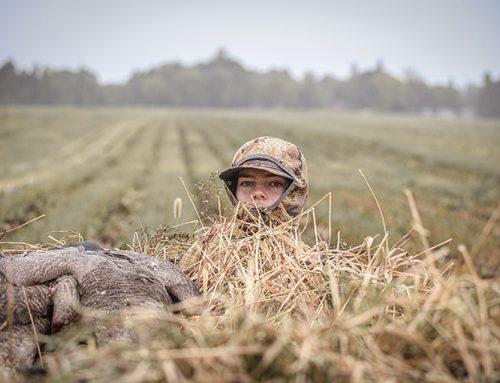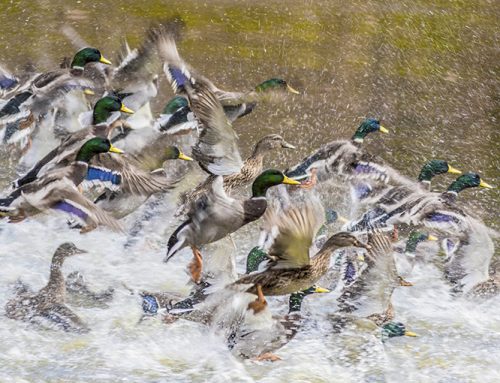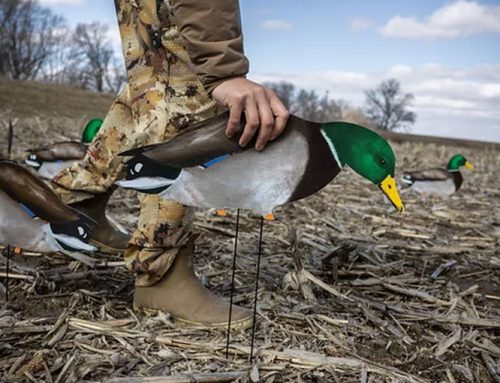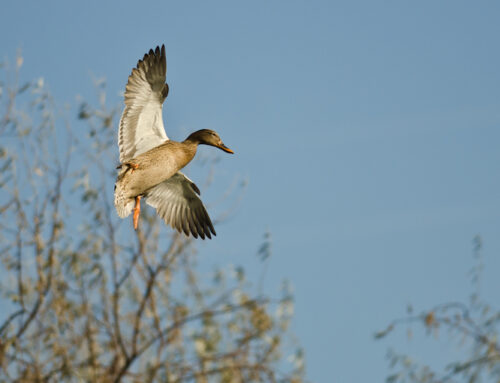Something was wrong. Flock after flock of geese ignored our decoys in the cut soy field for far too long. Yet, the birds were landing 200 yards away from our spread. They definitely wanted into the field. It was time to get out of the layout blinds and make changes.
The first step was to walk down the field in the direction the geese were approaching from and check our set-up from their view. Using the truck’s headlights and our flashlights, we had placed the decoys when only a hint of blue brushed the eastern horizon. Now in full daylight, it was obvious that many of the decoys were too close together, making the rig look like a bunch of nervous geese ready to take flight at the slightest disturbance. We immediately spread out the blocks of family groups, so they appeared more relaxed. We also noticed some of the decoys had fallen over. We righted them and made a quick visual check.
Related Articles
Then, we moved our portable blinds to the edge of the decoys where they would not be in the line of sight of approaching geese. This way, we hoped to get a shot at any birds that skirted the spread or flared at the last second. We had just finished moving them when a far-off honk sent us rushing back into our blinds.
Twelve geese crossed over the side road and headed toward the decoys. Even though they were 500 yards out, we could see them checking for something amiss, but a few clucks on a call reassured the birds that the field was safe. They locked wings, slipped sideways to lose altitude, and came in. On the edge of the spread, though, they got wise to the game and flared, but it was too late. We were right under them. The 20-yard shots were almost too close, as we cleanly picked five birds out of the flock. It seems like a dream hunt, but it was only made possible by changing our set-up.
Hunting geese is not always easy. For every successful trip, there are 10 hard slogs or simply skunks. Any number of things can go wrong: geese ignore your decoys, flare at what seems like nothing, or land in your field but are way out of range. These situations are maddening, but there are ways to tinker with your strategy to salvage a day. Here are some tried-and-true techniques to make sure your next day hunting wary Canadas is successful.
Prime Time Location
The most common problem goose hunters have is not being in the right spot at the right time. It’s not just about being in the right field; it’s about being in the right spot in that field. For example, if 100 geese land in a chosen location, they will quickly clean out the food in any particular spot. With this in mind, set up your decoys upwind closest to the spot with the most goose feathers and droppings that hasn’t been picked clean of food. This is where geese are most apt to land.
The birds are also averse to landing in holes or gullies in a field. They prefer hills, ridges, or — if it’s a flat field — the middle. Set up your blind with this in mind. Also, if you have to set up on the edge of a field but the birds are making circles without coming in or are landing outside the spread, don’t waste time in that spot. Pick up your blind and find a better location.
Mobility Counts
Portable blinds are great tools when you’re seeking the best location to set up for your hunt. And the good news is, if conditions change or you’re not having success in a specific location, you can simply grab your blind, carry it to a new spot, and lay it back down. Fully enclosed lightweight coffin/layout blinds or those that work in conjunction with a magnum goose decoy are good options, as are larger chair models that let you sit up while hunting. These blinds offer excellent mobility and concealment, which are often the keys to success. If you don’t have a portable blind, all is not lost. Many hunters simply hunker under camo material and hide behind decoys to shoot limits of geese. Make sure to properly conceal yourself with camo and stay still. While not the most comfortable way to hunt, it’s often the best solution if you want to bag wary birds.
Once you’ve found an ideal location, but the birds are still flaring, check your camo again. There’s a good chance you have concealment problems. Geese are smart and will become cautious when something looks out of place. Most birds will turn away from all but the most natural set-ups.
If geese continue to flare, get out of the blind and look for anything shiny or out of place. Spent shells, water bottles, white faces, and anything else reflecting light or colour can spook birds from your rig. Remember to put all non-camo gear in a camo bag or under a cover. Use a camo face mask or a small tube of hunter’s face paint to dull your face. Also look for decoys that have fallen over and set them upright again.
If geese are still flaring, but you can’t find an obvious cause, it could be the blind itself. This often happens on bright days when the sun casts shadows from your blind and geese can see every detail of the spread. If this happens, move your blind away from the centre of attention. If you’re hunting from a pit, move the decoys. Position the blind on the edge of the spread, upwind of the landing zone. This way, the blind will not be the centre of attention for geese checking out the decoys.
Another option is to leave the decoys and pass shoot the birds as they approach your spread. If the geese are wary of your blind, grab any gear that could be spooking them and hide 100 or more yards downwind where the birds have been crossing regularly on their way to the decoys. Hiding in a fencerow or a small weedy depression can be an advantage. When geese approach the decoys, hopefully, you will be underneath them and be able to take shots as they pass overhead. This works best when a stiff breeze is blowing, which makes the birds’ line of approach more predicable, or when they’re funnelled into a flight path because of trees, hills, or other obstructions.
Decoy Re-Deployment
If the birds are not committing to your set-up, but seem like they want to come in, change your decoy spread. Often, opening it up helps entice them. Reset the decoys into groups of 4 to 12, leaving 15 to 20 yards between them. This makes the spread look more like a relaxed group of geese, as well as creating the illusion of a larger flock. It will be harder to predict where birds want to land, so be ready to take advantage of any shooting opportunities.
Place your best decoys downwind and at the edges of the spread. Geese tend to come straight in after a long approach flying upwind, during which they will observe your set-up. With your best decoys up front, the birds will focus on them and fly into shooting range before they observe the less realistic ones. Put shells and silhouettes through the middle and upwind edges. This helps prevent any last-minute commitment problems with incoming flocks.
If you use a spinning-wing duck decoy to pull in bonus ducks, remember to keep it turned off when geese are working the field. Geese often don’t like these decoys. Keep them close to the blind, so you can reach out and turn them off when geese are about. Some of the newer models have remote controls that are perfect for a goose and duck combo hunt.
A Simple Diversion
In a large field, geese landing away from the spot you’ve set up can be aggravating. A possible solution is to park your truck in the field (with land-owner permission, of course) where the geese are landing. This should deter them from landing there and, hopefully, coax them closer to your spread. Just make sure the truck is far enough away not to spook the birds from your set-up. If you don’t want to park in the field, try another diversion — something bright like a hunter orange coat, a large cooler, or a children’s yard toy. All work to detour geese away from a favoured spot towards your spread.
The Calling Game
If you’ve hunted Canadas for some time, I’m sure you’re familiar with this scenario.
You’ve set up your decoys in a promising field and, lo and behold, the geese come in and land in the field adjacent to yours. That’s great, but, of course, you don’t have permission to hunt there. Changing decoy set-ups or applying the requisite camo is not going to help you in this scenario. This is when patience and calling are your best options.
Both worked well a few years back when I was hunting ducks from a boat blind with fellow OOD Field Editor Bob Bailey. Not expecting geese, we hadn’t put out floating goose decoys that morning. During a lull in the duck flight, we could hear geese honking far off in the distance. We searched the sky for the flock and finally spied them in perfect V formation high up, heading south. With nothing to lose, we started to call to the birds. Nothing happened at first, but then, the rear birds started breaking formation. Soon, the whole flock broke rank and made a rapid descent to our decoys. We were astonished. Once the shooting was over, three geese were on the water. Even though we were not hunting geese at the time, our persistent calling had coaxed the birds to come our way.
Call aggressively the next time you encounter geese that look like they will bypass your location. Honk and cluck, growl, and honk again. Make sure everyone in your hunting party joins in. The goal is to break the flock into a disorganized mob, prompting some birds to land where you want them. Keep calling until you start pulling the trigger.
Not all flocks will respond to your persistent calls, of course, but it’s worth a try. This technique usually works best with smaller flocks.
Change It Up
Goose hunting is one of the most challenging forms of waterfowling. And even though you may dream of flight after flight of big birds storming your spread with unwavering commitment, chances are, this just won’t happen. The key is to stay focused and alter your strategies if birds are not co-operating. A few slight adjustments can turn dreams into reality.







Leave A Comment